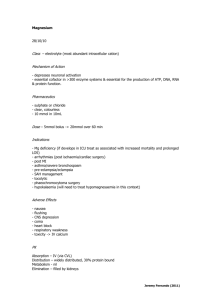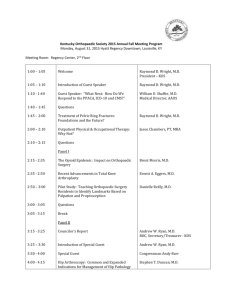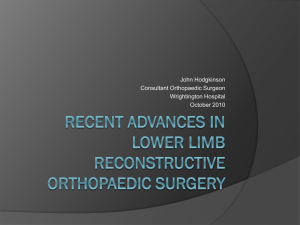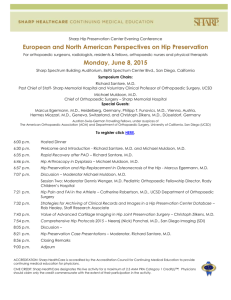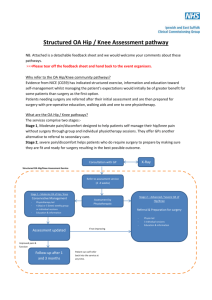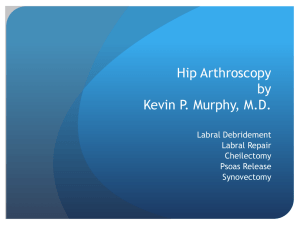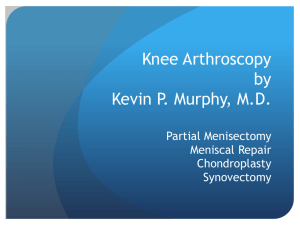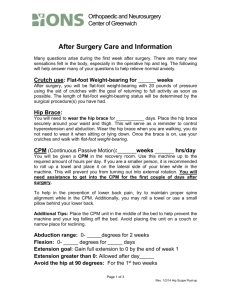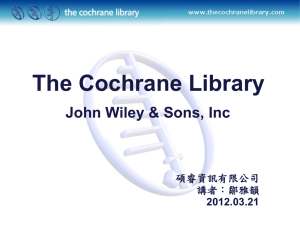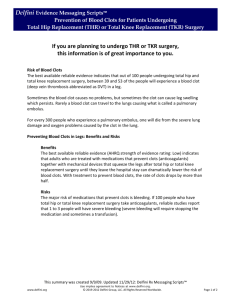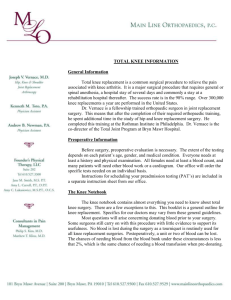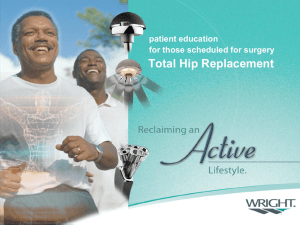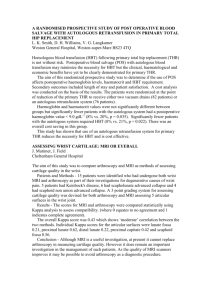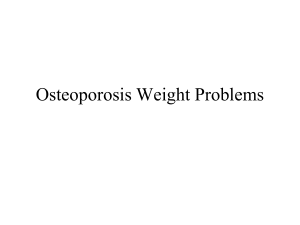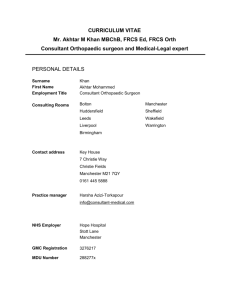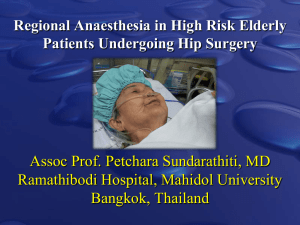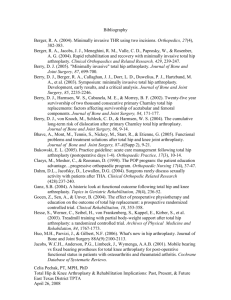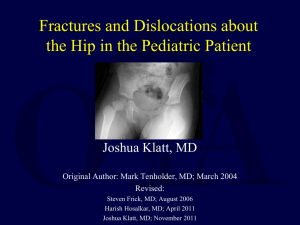Evidence Based Orthopaedic Surgery
advertisement
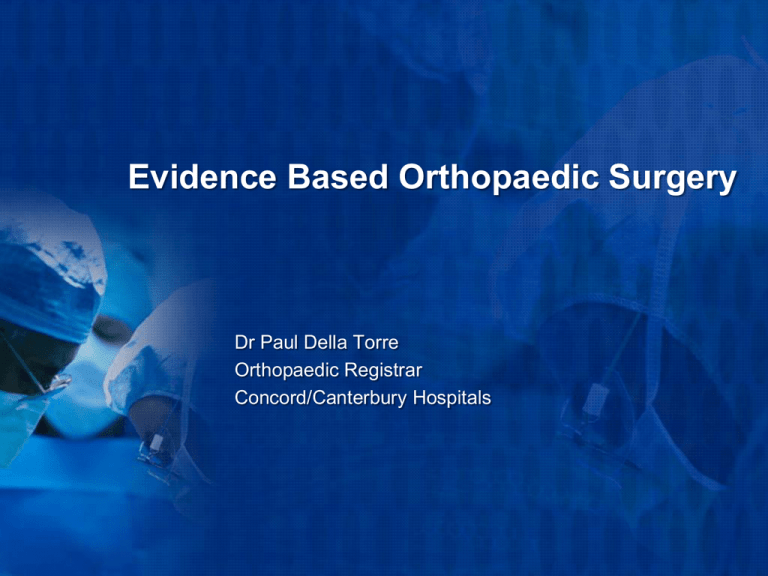
Evidence Based Orthopaedic Surgery Dr Paul Della Torre Orthopaedic Registrar Concord/Canterbury Hospitals History of EBM • 1747 James Lind Ships Surgeon, British Navy First ever systematic clinical trial, basic principles 6 interventions for scurvy prevention Citrus of proven benefit Implemented in voyages of James Cook, and British Navy 1795. • Questions established systems • Locate, evaluate, incorporate best available research into clinical practice Evidence Based Medicine • Defined as “…the conscientious, explicit, and judicious use of current best evidence in making decisions about the care of individual patients.” Sackett et al, BMJ 1996. • Evidence based practice involves integrating clinical expertise with: Best available evidence Patient factors/preferences Priorities Resources etc. Process of EBM • • • • • • Formulate clinical question Locate evidence Critical appraisal Incorporate into clinical practice Evaluate effect of change on performance Review practice, modify as required Levels of Evidence • Oxford Centre for Evidence Based Medicine (CEBM) www.cebm.net • Study question types: I Therapy / Prevention, Aetiology / Harm Prognosis Diagnosis Differential diagnosis / symptom prevalence study Economic and decision analyses II Quality III IV Bias V Study Type • Therapy RCT > Cohort > Case control > Case series • Diagnosis Cross-sectional analytic study • Aetiology/Harm Cohort > Case control > Case series • Prognosis Cohort study > Case control > Case series • Prevention RCT > Cohort > Case control > Case series • NB: SYSTEMATIC REVIEWS (including Meta Analysis) – Highest level evidence for each study type/ Definitions • Systematic Review Overview of scientific literature on a specific problem Thorough, defined literature search Appraisal of individual studies identified Summary of studies • Meta Analysis Statistical technique Combination of data from similar studies Quantitative summary Weighted average of individual study effects. Where to look? • Cochrane Collaboration Founded 1993, named after Archie Cochrane Not for profit Independent Updated • Produce: Cochrane Database of Systematic Reviews (Quarterly) Cochrane Library • www.cochrane.org How to Find… • www.ciap.health.nsw.gov.au Librarian IT Support CIAP Representative Cochrane Library Cochrane Systematic Reviews • Abstract Background Search strategy Selection criteria Data collection, analysis Main results Authors' conclusions • Plain language summary • PDF download Summary Main review Level 1 Evidence Recommendations A balanced approach • Exercise for improving balance in older people 34 studies, 2883 participants Interventions involving gait; balance; co-ordination and functional exercises; muscle strengthening; and multiple exercise types have greatest impact on balance. Limited evidence that effects were long-lasting. Overall, a lack of standardised outcome measures limiting conclusions re. efficacy. Defy gravity? • Interventions for preventing falls in older people living in the community ~30% of people over 65 years of age living in the community fall each year 111 trials, 55,303 participants Reduced rate of falls and risk of falling: o Multiple-component group exercise o Individually prescribed multiple-component home-based exercise o Tai Chi Reduced rate of falls: o o o o Assessment and multifactorial intervention Gradual withdrawal of psychotropic medication First eye cataract surgery Pacemakers in carotid sinus hypersensitivity Reduced risk of falls: o Home safety interventions in patients with severe visual impairment o Prescribing modification programme for primary care physicians Does being hippy help? • Hip protectors for preventing hip fractures in older people 15 studies, over 15,000 elderly rest or nursing home residents or older adults living at home. No or marginal reduction in hip fracture, pelvic or other fractures incidence No major adverse effects reported Compliance, particularly in the long term is poor due to discomfort and practicality To cement or not to cement…? • Arthroplasties (with and without bone cement) for proximal femoral fractures in adults 19 trials, 2115 patients No significant difference for unipolar vs bipolar hemiarthroplasty. Tendancy for cemented hemiarthroplasty to reduce postop pain and improved mobility at 1yr postop. No significant difference in surgical complications between cemented and uncemented Significantly longer operative times, but better functional outcome scores for THR. To drain or not to drain…? • Closed suction surgical wound drainage after orthopaedic surgery 36 studies, 5464 participants with 5697 surgical wounds Hip/knee replacement, shoulder surgery, hip fracture surgery, spinal surgery, ACL reconstruction, open meniscectomy and fracture fixation surgery No difference in wound infection, haematoma, dehiscence or re-operation rate Blood transfusion required more frequently with drains Reinforcement of wound dressings and bruising more common without drains Insufficient evidence from randomised trials to support the routine use of closed suction drainage in orthopaedic surgery. To stop the clot • Heparin, LMW heparin and physical methods for preventing DVT and PE following surgery for hip fractures 31 trials, 2958 female and elderly patients Unfrac and LMW heparins protect against lower limb DVT Foot and calf pumping devices appear to prevent DVT, may protect against PE, and reduce mortality, but compliance a problem Trial quality an issue Aspirin needs to be included Running on bone • Exercise for osteoarthritis of the knee 32 studies, 3616 participants Outcome of improved physical function Dependant on provision of a supervised exercise program Land-based therapeutic exercise has short term benefit in reduction of knee pain and improved physical function in knee OA Magnitude of the treatment effect comparable to estimates reported for NSAID drugs The ankle dilemma • Immobilisation and functional treatment for acute lateral ankle ligament injuries in adults 21 trials, 2184 participants Functional treatments compared with immobilisation No differences between varying types of immobilisation, immobilisation and physiotherapy or no treatment Functional treatment was found to improve: o o o o o o o Number returning to sport in the long term Time taken to return to sport Return to work at short term follow-up Time taken to return to work was shorter Likelyhood of persistent swelling at short term follow-up Numbers suffering from objective instability as tested by stress X-ray Patient satisfaction Many low quality trials, most of differences not significant when excluded What to pop… • Paracetamol for osteoarthritis 15 studies, 5986 participants Compare efficacy and safety of paracetamol versus placebo versus NSAIDs for treating OA NSAIDs are superior to paracetamol for improving knee and hip pain due to OA. In OA with moderate-to-severe levels of pain, NSAIDs are more effective than paracetamol. Questions?
